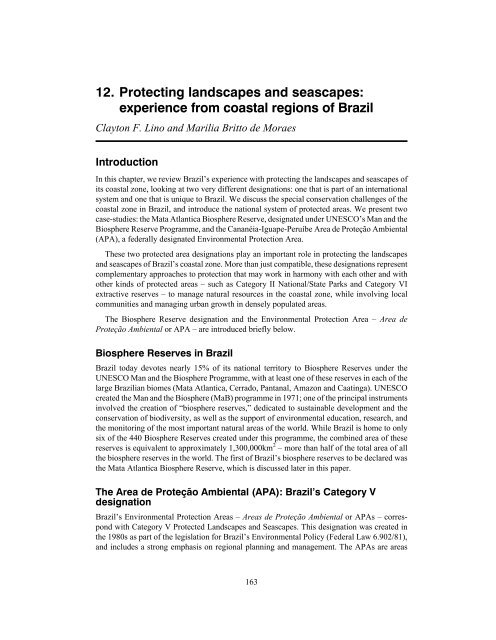The Protected Landscape Approach - Centre for Mediterranean ...
The Protected Landscape Approach - Centre for Mediterranean ...
The Protected Landscape Approach - Centre for Mediterranean ...
Create successful ePaper yourself
Turn your PDF publications into a flip-book with our unique Google optimized e-Paper software.
12. Protecting landscapes and seascapes:<br />
experience from coastal regions of Brazil<br />
Clayton F. Lino and Marilia Britto de Moraes<br />
Introduction<br />
In this chapter, we review Brazil’s experience with protecting the landscapes and seascapes of<br />
its coastal zone, looking at two very different designations: one that is part of an international<br />
system and one that is unique to Brazil. We discuss the special conservation challenges of the<br />
coastal zone in Brazil, and introduce the national system of protected areas. We present two<br />
case-studies: the Mata Atlantica Biosphere Reserve, designated under UNESCO’s Man and the<br />
Biosphere Reserve Programme, and the Cananéia-Iguape-Peruíbe Area de Proteção Ambiental<br />
(APA), a federally designated Environmental Protection Area.<br />
<strong>The</strong>se two protected area designations play an important role in protecting the landscapes<br />
and seascapes of Brazil’s coastal zone. More than just compatible, these designations represent<br />
complementary approaches to protection that may work in harmony with each other and with<br />
other kinds of protected areas – such as Category II National/State Parks and Category VI<br />
extractive reserves – to manage natural resources in the coastal zone, while involving local<br />
communities and managing urban growth in densely populated areas.<br />
<strong>The</strong> Biosphere Reserve designation and the Environmental Protection Area – Area de<br />
Proteção Ambiental or APA – are introduced briefly below.<br />
Biosphere Reserves in Brazil<br />
Brazil today devotes nearly 15% of its national territory to Biosphere Reserves under the<br />
UNESCO Man and the Biosphere Programme, with at least one of these reserves in each of the<br />
large Brazilian biomes (Mata Atlantica, Cerrado, Pantanal, Amazon and Caatinga). UNESCO<br />
created the Man and the Biosphere (MaB) programme in 1971; one of the principal instruments<br />
involved the creation of “biosphere reserves,” dedicated to sustainable development and the<br />
conservation of biodiversity, as well as the support of environmental education, research, and<br />
the monitoring of the most important natural areas of the world. While Brazil is home to only<br />
six of the 440 Biosphere Reserves created under this programme, the combined area of these<br />
reserves is equivalent to approximately 1,300,000km 2 – more than half of the total area of all<br />
the biosphere reserves in the world. <strong>The</strong> first of Brazil’s biosphere reserves to be declared was<br />
the Mata Atlantica Biosphere Reserve, which is discussed later in this paper.<br />
<strong>The</strong> Area de Proteção Ambiental (APA): Brazil’s Category V<br />
designation<br />
Brazil’s Environmental Protection Areas – Areas de Proteção Ambiental or APAs – correspond<br />
with Category V <strong>Protected</strong> <strong>Landscape</strong>s and Seascapes. This designation was created in<br />
the 1980s as part of the legislation <strong>for</strong> Brazil’s Environmental Policy (Federal Law 6.902/81),<br />
and includes a strong emphasis on regional planning and management. <strong>The</strong> APAs are areas<br />
163

















